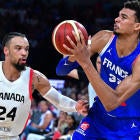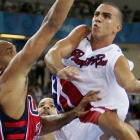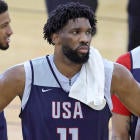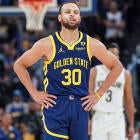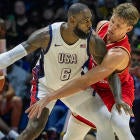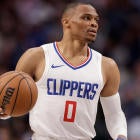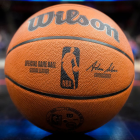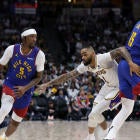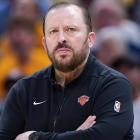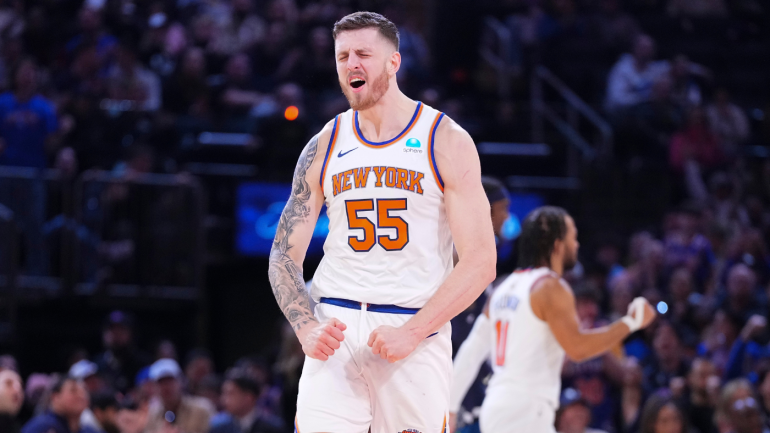
In the small north German town of Quakenbrück, a 14-year-old Isaiah Hartenstein chafed at his coach's instructions. He was one of the country's best players in his age group, and, for a portion of each game, he was flat-out forbidden from scoring.
"It was the third quarters," Hartenstein said. "Like, 'You're only allowed to pass the ball now.'"
Hartenstein grew up playing on the perimeter, so he had guard skills. The coach -- his father, Florian, a longtime pro in Germany -- wanted him to hone his court vision and think pass-first. Florian, a 6-foot-9 bruiser, saw his son becoming much more than that.
"I hated it at the time," Hartenstein said. "But I think he saw the bigger picture."
A decade later in New York, Hartenstein was coming off a strong season with the Los Angeles Clippers, in which the 7-footer had thrived as a facilitator, showing off the skills he'd been sharpening since he was small. Knicks coach Tom Thibodeau, however, didn't need him to be a handoff hub or high-post passer. Thibodeau needed him to protect the paint, rebound, set solid screens and roll hard to the rim. To play, essentially, more like his father.
About a month into the 2022-23 season, Hartenstein told reporters that he was trying to adapt to his limited role while dealing with inflammation in his Achilles tendon. It was not clear then that things would work out for him in New York, let alone that he'd become a fan favorite the way he has this season. Over time, Hartenstein's role evolved. He got good at the grunt work, and he blended it with the playmaking.
"Coming in, it took us some time to adjust," Hartenstein said. "But I think, unless you're really the top guy on any team, you're going to have to adjust to a certain role. You're not going to be able to do everything you want. So, I mean, if you want to be a winning player, you have to be able to do it. Now I'm in a perfect situation, where I'm allowed to play my game, and it's been working really well."
Hartenstein has put himself in the mix for All-Defense, helped his team withstand several injuries and personified its resolve. Over the course of the season, Hartenstein's per-possession scoring and assist averages are not quite as impressive as they were with the Clippers, but lately they've been even better. And since Mitchell Robinson's ankle injury in January, he has held down the interior for the league's sixth-best defense.
Last week, Hartenstein had 20 points, eight rebounds, three assists, a steal and two blocks in Denver, then followed it up with 17 points, nine rebounds, two assists, four steals and two blocks against Brooklyn. Both stat lines required just 26 minutes -- Hartenstein has been on a minutes restriction since the Achilles issue popped up again in February -- but neither totally captures what he means to the Knicks. He is a different, more complete player than he was when he arrived in New York, one who can contribute with or without getting touches.
"Now I showed that I can still score, I can still pass, but at the end of the day, whatever the team needs, I'm able to adjust," Hartenstein said. "And I think that's what a lot of players in the league can't do. That's why some of them kind of fall out of the league, 'cause they're not able to adjust to what the team needs at that time."
It was not particularly surprising when, in 2020, before the NBA restarted its season at Disney World, the Rockets waived Hartenstein. They'd drafted him (No. 43, 2017) and he'd won Finals MVP with their G League affiliate (2019), but he no longer fit their vision, his presence on the roster reduced to a footnote in the story of their smallball experiment. Given that he wasn't playing, he asked them to release him.
Denver was different. He signed with the Nuggets before the 2020-21 season, and, their offense, built around Nikola Jokic, the league's preeminent point center, seemed like a perfect fit. So why didn't Hartenstein even last a full season?
"I don't care what anyone says, playing behind Jokic is not easy," Hartenstein said. "You get an eight-minute stint where, no matter how good you play, it's never going to be a similar impact to Jokic. I mean, I don't think really any backup center really has worked with them lately."
Looking back, though, Hartenstein said he takes responsibility for not making it work. "At that point, I put too much pressure on myself," he said. This was when his confidence wavered and he started working on the mental side of the game.
In 30 games with the Nuggets, Hartenstein had a negative assist-to-turnover ratio and committed 7.8 fouls per 36 minutes. The experience was valuable, though, because he got to watch and learn from Jokic.
"I would always look at my teammate to pass to, but [Jokic] is always looking at the defender," Hartenstein said. "If [the defender's] head is not turned, sometimes you can still throw it in in front of him because the defender doesn't know where the ball is."
Through Jokic, Hartenstein picked up the art of "playing games with your eyes," he said. Sometimes, a simple look can move a defender and open up a passing lane. In his first game after Denver traded him to Cleveland for JaVale McGee, Hartenstein dished seven assists in 26 minutes. "I thought I played really well there," he said, but it would be just a 16-game stint. The following offseason, the Cavs added No. 2 pick Evan Mobley and 7-footer Lauri Markkanen to a big-man rotation that already featured Jarrett Allen and Kevin Love. Hartenstein, having declined his player option, signed a training-camp deal with the Clippers.
In Los Angeles, it appeared Hartenstein might have found his place in the NBA. "That was the first time I felt comfortable," he said. He beat out Harry Giles for a roster spot and Serge Ibaka for the backup center role, and coach Ty Lue empowered him. "Isaiah pretty much becomes our point guard and so we kind of run our offense through him," Lue told reporters back then. His chemistry with guards Luke Kennard and Terance Mann "made the second unit special," Hartenstein said, and the Clippers outscored opponents by 7.7 points per 100 possessions with him and Kennard on the court.
The Clippers, however, effectively chose John Wall over him, as Hartenstein sees it, so he went to New York in the 2022 offseason on a two-year, $16 million deal that has become one of the league's biggest bargains. After all of this bouncing around -- and several twists and turns with the Knicks -- Hartenstein takes pride in "mentally being ready for whatever," he said.
"At the beginning of the year, when I was playing more backup minutes, I was still keeping myself ready just in case I had to play starter minutes," Hartenstein said. "That's been the main focus, and that's why I also tell young guys that the NBA changes so quick." Hartenstein noted that teammate Miles McBride recently logged a full 48 minutes, three months after getting DNP-CDs. "That's how the NBA is."
On Thursday, a clip from Hartenstein's appearance on Jalen Brunson and Josh Hart's podcast went viral. "Let's just jump right into it," Brunson says. "Are you Black?' Before Hartenstein can answer, Hart asks him to "explain your Blackness." Hartenstein responds by describing himself as "brightskin," a skin tone "above lightskin."
On the podcast, he continues: "My dad is probably the same skin tone as y'all, but my mom's genes probably took over with that." This surprised people who missed Andscape's pre-draft story on Hartenstein, memorably headlined, "There's more to Isaiah Hartenstein than meets the eye." (The subheading reads, "NBA draft prospect appears to be white, but he's also black.")
Three days earlier, asked about Hartenstein's defense in the Knicks' locker room at Madison Square Garden, Hart said, "As a defender, probably people underestimate him because they don't think he's Black. They don't think he's as athletic as a Black guy."
Hartenstein is "a smart basketball player," Hart said. In drop coverage, "he's able to make reads on the fly and be effective with that. And then obviously he's athletic enough to either go deter a shot at the end when he makes that decision to contest it, or he's tough to throw the ball over for a lob. So I think just the combination of his IQ, his athleticism and just good positioning."
With 10 games remaining in the regular season, Hartenstein is second in the entire league in defensive estimated plus-minus, per dunksandthrees.com. He was not always, however, one of the premier practitioners of the drop.
"I think coming into the league, defense was something that kept me off the court," Hartenstein said. "I think a lot of people in those situations kind of whine [and] talk about, 'Why am I not playing that much?' What I did is, in the summer, I would really watch a lot of Draymond."
What he did, he said, was "what a lot of people don't want to do. Most of the guys coming in in the summer just want to work on their offensive game. But offense wasn't keeping me off the court. It was defense. So that's what I worked on in the summer. Especially with my dad." Against pick-and-rolls, Hartenstein needed to be active enough to prevent open pull-ups while staying in position to prevent alley-oops. He needed to master the cat-and-mouse game that is nowhere near as easy as Draymond Green makes it look.
You have to make the ballhandler "think about it," Hartenstein said. "I think I do a good job of not giving the guard an easy look. If it's him coming off, [I'm] faking at him, going back to mine, committing late to him. Or he tries to throw a lob, I kind of bait him into throwing it and then stealing the ball from that."
Thibodeau said that Hartenstein is "terrific" at defensive decision-making, taking into account New York's game plan, what the opponent is trying to get to and the personnel involved. When describing his role, the first thing Hartenstein mentioned was "just playing hard," which is another thing that "a lot of players don't want to do." He said that "anchoring the defense" is part of the job, too.
"There's a certain foundation that Thibs demands," New York wing Donte DiVincenzo said, and this is especially true for bigs. "First and foremost, we're going to do XYZ. If you can't do XYZ, we're going to get somebody who can do XYZ." The "beauty in having Isaiah," though, is that "he does everything and more."
When Julius Randle dislocated his shoulder in late January, the Knicks found themselves in need of different sources of offense. They'd already lost some shot creation when they swapped Immanuel Quickley and RJ Barrett for OG Anunoby and Precious Achiuwa a month earlier, and it didn't help that Anunoby was also injured, which left them short on spacing. Opponents responded by blitzing Brunson more than anybody other than Luka Doncic. This opened up opportunities for Hartenstein the playmaker.
"I don't think there's a lot of bigs that know how to play in that pocket like I do, know how to pass out of the pocket, make those reads," he said.
Thibodeau said that Hartenstein is "very good flashing to the elbow" and being an outlet, and that New York has been playing out of "Delay" a lot (i.e. starting possessions with 5-out spacing and the ball in Hartenstein's hands at the top of the key). The offense hasn't changed, exactly, but it looks different than it did for much of Hartenstein's tenure. Out of necessity, it has tilted toward movement, and the ball has found Hartenstein. In turn, he has found cutters.
Statistically, for the last 15 games, Hartenstein has been sort of like Alperen Sengun, if you can imagine a version of the Rockets center that doesn't get post-up touches, takes half as many shots, rebounds a bit better and is one of the best rim protectors in basketball.
"I describe him as a comfort blanket for us," DiVincenzo said. "If you cut, you know he's going to make the pass. If you want a screen, you know he's going to set a hard screen. If you're in coverage, you know he's going to call out the coverage. And if you switch, you know you have confidence that he's behind you to clean up any mess."
After playing heavy minutes as the Knicks shot up the standings in January, Hartenstein's minutes restriction has taken some getting used to. He said he feels healthy enough to play more than he has been, but the plan was to "build up to the playoffs." Thibodeau does not exactly have a reputation for being conservative in this regard, but Hartenstein credited him and the Knicks' medical staff for their approach.
"Having the medical staff and Thibs have that mindset and also really care about my health. I think that's been big," he said. "Because, knowing myself, I would always kind of push it."
DiVincenzo said that Hartenstein has "been productive in all facets," regardless of playing time, role or how his Achilles has been feeling. When Robinson returned from his 15-plus-week absence on Wednesday, Hartenstein remained in the starting lineup. That could change in between now and the playoffs, but Hartenstein will do his thing either way.
"Mitch goes down and everybody from the outside world is saying, oh, we're facing this, we're facing that," DiVincenzo said. "And he's come in and done his job way [better] than anybody expected. And now you get reinforcements back. with Mitch coming back. Now you have to deal with it for 48 minutes."
The Knicks are third in the East, and Hartenstein couldn't be happier with their style of play. "I think we have a lot of unselfish players and that makes my life easier," he said. In some ways, the future is hazy, given the uncertainty around Randle and Anunoby's injuries and the fact that Hartenstein will be a free agent again in July (and New York has only his Early Bird rights, meaning it can't sign him to a starting salary higher than $16 million). In other ways, though, Hartenstein has never stood on such solid ground.
"I think I've proven that, no matter what big comes in, it's a matchup," Hartenstein said. "I don't think, any big that ever comes in, I'm scared of or anything. I think I've established that I'm a starter in the NBA. I can play a big role on a winning team."










